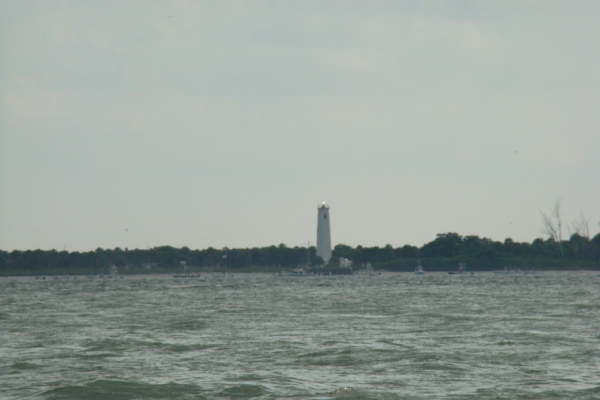 Re: 24 lighthouses, 4 lantern rooms, 6,271 miles, $1,011 for gas, 16 day
#66139
07/06/08 01:52 AM Re: 24 lighthouses, 4 lantern rooms, 6,271 miles, $1,011 for gas, 16 day
#66139
07/06/08 01:52 AM
|
Joined: Dec 2002
Posts: 1,964
sandy
 OP
OP
Cruise Director
|
OP

Cruise Director
Joined: Dec 2002
Posts: 1,964 |
Last stop on this trip was Egmont Key Lighthouse, Tampa Bay, FL. This 1858-built, active 85' tower has 3' thick brick walls and replaced an 1848 tower. Egmont Key became a National Wildlife Preserve in 1974 and the lighthouse joined the National Register of Historic Places in 1978. Automated, a radiobeacon is emitted from a 133' antenna located next to the lighthouse. A fixed-light produced by a 3rd-Order Fresnel lens was exhibited from a focal plane of 86'. A struggle for control of the lighthouse during the Civil War resulted in the lens being crated and moved to Tampa by the keeper. After the war a 4th-Order lens was used until 1893 when it was replaced by a 3rd-Order lens with a red sector. During the Spanish-American War, Fort Dade was constructed on the island. The fort, along with Fort DeSoto on Mullet Island to the northeast, stood watch over the entrance to Tampa Bay. The fort was staffed during WW I as well, and by the time it was deactivated in 1923, a movie theater, bowling alley, tennis courts, and miles of brick roads were found on the island. The upper portion of the lighthouse was removed in 1944, as was the Fresnel lens. A Double Head DCB-36 Rotating Beacon was placed on top of the capped tower in 1989. The remaining keeper’s dwelling was demolished in1954 and replaced by a 1-story barracks. Florida’s Park Service and the US Fish and Wildlife Service manage the island today.  The plan had been to travel to Boca Grande for those lights, then finish up with Cape Canaveral before heading home, but I opted instead to leave Egmont Key and head back to CT. I’d called the tour bus company in Cape Canaveral and was told there was only one trip passing the lighthouse daily and that trip left at 1:30 PM. Had we gotten on board for that trip on Friday our return to CT would have taken another day, so we put Cape Canaveral and the Boca Grande lights on a back burner and see them on a trip to Florida that we’ll probably take in February. Hope you’ve enjoyed this journey–we’ve enjoyed the company. . . .
|
|
|
|
Entire Thread
|

 24 lighthouses, 4 lantern rooms, 6,271 miles, $1,011 for gas, 16 day
24 lighthouses, 4 lantern rooms, 6,271 miles, $1,011 for gas, 16 day
|
sandy
|
07/06/08 05:49 AM
|

 Re: 24 lighthouses, 4 lantern rooms, 6,271 miles, $1,011 for gas, 16 day
Re: 24 lighthouses, 4 lantern rooms, 6,271 miles, $1,011 for gas, 16 day
|
sandy
|
07/06/08 05:50 AM
|

 Re: 24 lighthouses, 4 lantern rooms, 6,271 miles, $1,011 for gas, 16 day
Re: 24 lighthouses, 4 lantern rooms, 6,271 miles, $1,011 for gas, 16 day
|
sandy
|
07/06/08 05:50 AM
|

 Re: 24 lighthouses, 4 lantern rooms, 6,271 miles, $1,011 for gas, 16 day
Re: 24 lighthouses, 4 lantern rooms, 6,271 miles, $1,011 for gas, 16 day
|
sandy
|
07/06/08 05:50 AM
|

 Re: 24 lighthouses, 4 lantern rooms, 6,271 miles, $1,011 for gas, 16 day
Re: 24 lighthouses, 4 lantern rooms, 6,271 miles, $1,011 for gas, 16 day
|
sandy
|
07/06/08 05:51 AM
|

 Re: 24 lighthouses, 4 lantern rooms, 6,271 miles, $1,011 for gas, 16 day
Re: 24 lighthouses, 4 lantern rooms, 6,271 miles, $1,011 for gas, 16 day
|
sandy
|
07/06/08 05:51 AM
|

 Re: 24 lighthouses, 4 lantern rooms, 6,271 miles, $1,011 for gas, 16 day
Re: 24 lighthouses, 4 lantern rooms, 6,271 miles, $1,011 for gas, 16 day
|
sandy
|
07/06/08 05:52 AM
|

 Re: 24 lighthouses, 4 lantern rooms, 6,271 miles, $1,011 for gas, 16 day
Re: 24 lighthouses, 4 lantern rooms, 6,271 miles, $1,011 for gas, 16 day
|
MtnHkr
|
07/06/08 02:29 PM
|

 Re: 24 lighthouses, 4 lantern rooms, 6,271 miles, $1,011 for gas, 16 day
Re: 24 lighthouses, 4 lantern rooms, 6,271 miles, $1,011 for gas, 16 day
|
Lighthouse Loon
|
07/06/08 05:08 PM
|

 Re: 24 lighthouses, 4 lantern rooms, 6,271 miles, $1,011 for gas, 16 day
Re: 24 lighthouses, 4 lantern rooms, 6,271 miles, $1,011 for gas, 16 day
|
Bill and Judy
|
07/06/08 10:06 PM
|

 Re: 24 lighthouses, 4 lantern rooms, 6,271 miles, $1,011 for gas, 16 day
Re: 24 lighthouses, 4 lantern rooms, 6,271 miles, $1,011 for gas, 16 day
|
Dave H
|
07/07/08 04:49 PM
|

 Re: 24 lighthouses, 4 lantern rooms, 6,271 miles, $1,011 for gas, 16 day
Re: 24 lighthouses, 4 lantern rooms, 6,271 miles, $1,011 for gas, 16 day
|
kikigl
|
07/08/08 08:38 PM
|

 Re: 24 lighthouses, 4 lantern rooms, 6,271 miles, $1,011 for gas, 16 day
Re: 24 lighthouses, 4 lantern rooms, 6,271 miles, $1,011 for gas, 16 day
|
Bob Taylor
|
07/09/08 02:00 PM
|

 Re: 24 lighthouses, 4 lantern rooms, 6,271 miles, $1,011 for gas, 16 day
Re: 24 lighthouses, 4 lantern rooms, 6,271 miles, $1,011 for gas, 16 day
|
sandy
|
07/09/08 02:20 PM
|

 Re: 24 lighthouses, 4 lantern rooms, 6,271 miles, $1,011 for gas, 16 day
Re: 24 lighthouses, 4 lantern rooms, 6,271 miles, $1,011 for gas, 16 day
|
wheland
|
07/09/08 03:34 PM
|

 Re: 24 lighthouses, 4 lantern rooms, 6,271 miles, $1,011 for gas, 16 day
Re: 24 lighthouses, 4 lantern rooms, 6,271 miles, $1,011 for gas, 16 day
|
Tybee_Sullivan
|
07/10/08 09:42 PM
|
|
|
|
Forums39
Topics16,980
Posts184,642
Members2,583
| |
Most Online10,155
Jan 14th, 2020
|
|
|
0 registered members (),
1,807
guests, and 0
spiders. |
|
Key:
Admin,
Global Mod,
Mod
|
|
|

